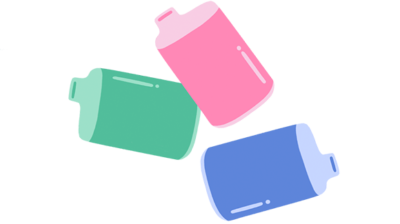How to handle nicotine withdrawal from smoking or vaping
When you give up nicotine, your body can go into withdrawal. This only temporary and there are ways to manage it.

Usually when people quit smoking or vaping they experience withdrawal symptoms, which are a physical or mental reaction to stopping use of a drug. Nicotine is the drug in cigarettes, tobacco, and e-cigarettes (vape) and although it is legal, it is addictive.
Although withdrawal symptoms can be tough, they are temporary. The first two to three days after giving up nicotine are the hardest, but they usually stop within one to three months of quitting. If you are experiencing withdrawal symptoms you can get past them and there are supports available to help. Find out about getting support to quit smoking or vaping at the end of this page.
What are the symptoms of nicotine withdrawal?
You may experience different kinds of withdrawal symptoms after giving up smoking or vaping. Everyone is different and some people might experience different or worse symptoms than others. Although it is hard, there are so many benefits to quitting smoking that quitting smoking is definitely worth it.
If you want to quit smoking or vaping but you don’t know how to start, there are many ways you can get started. Find out how to quit smoking.
These are some of the withdrawal symptoms people might experience:
Coughing
When you stop smoking your lungs will start to clear debris that has built up while you smoke. Cilia, small hair like structures in your lungs, start to grow back. The job of cilia is to clear mucus from your lungs. This might cause you to develop a cough while your body clears out toxins and debris associated with smoking.
Craving cigarettes
Nicotine withdrawal can start within 30 minutes of your last cigarette and can continue for up to six weeks. They usually last five to 20 minutes. It can be very tough to deal with cravings. Be aware that they will pass eventually. Distract yourself by doing something else. Going for a brisk walk or having an ice cold glass of water can help.
Some people find the ‘5 Ds’ helpful:
- Distract yourself by focusing on something else
- Delay doing anything about your craving until the urge passes
- Deep breathing – take 20 deep breaths
- Drink a glass of cold water or fruit juice
- Don’t dwell on it – try your best not to get caught up in thoughts about your cravings
Remember, be kind to yourself as you deal with cravings. Giving up nicotine is not easy.
Change in energy levels
Nicotine is a stimulant, meaning it perks you up. This means that during nicotine withdrawal, you may experience periods of fatigue, or low energy, and periods of higher energy. In the long run, giving up smoking or vaping will give you to have more energy as your body works more efficiently.
Sleep disturbances
When you are addicted to nicotine your body will go into withdrawal every two hours. This can affect your quality of sleep. In the period after quitting smoking or vaping this will get worse before it gets better.
Nicotine also affects your hormones, particularly dopamine. Dopamine plays a part in keeping you alert and awake. This will take some time to regulate again. Once withdrawal symptoms get better and your hormones regulate again you will experience better sleep in general.
Read about the basic science of sleep.
Feeling miserable
Some people experience flu-like symptoms after quitting smoking or vaping. This will pass after a few days. Drink water, eat healthily and give yourself time to rest.
How to deal with nicotine withdrawal symptoms
The healthier you are, the less likely you are to start smoking or vaping again. Try to look after your basic health and wellness goals each day to give yourself the best chance of quitting smoking or vaping. If your body and mind are generally feeling healthy you will be better able to deal with cravings.
It might help to have these healthy routines in place before you quit. You will be better able to cope with symptoms and are more likely to be successful.
Regulate blood sugar and eat nutritiously
When you smoke your stress hormone cortisol increases. This leads to an increase in insulin which in turn leads to blood sugar dropping. When blood sugar is low people usually crave a quick fix to increase it again. Sugar, caffeine and alcohol (which is a sugar) can provide a quick fix. People who are attempting to quit smoking or vaping may crave sugar as a result.
When blood sugar is irregular, cigarette cravings can be worse and less manageable. Protein, good fats and fibre can help regulate blood sugar. Including these in each meal, along with least two fruits or vegetables, could help you feel better and make it easier to cope with cigarette cravings.
Eating lots of nutritious fruit and vegetables can help provide your body with the nutrition it needs to help deal with the toxins and chemicals in your body from smoking. Protein helps your body to grow and repair the damage done from smoking.
Keep up a regular sleep pattern
An important part of looking after your wellbeing is to get enough good quality sleep. Try to take some time to unwind before bed by doing something relaxing like reading or meditating. Avoiding screens for a period of time before bed can help you to relax.
After quitting smoking or vaping, nicotine withdrawal can cause disturbances to sleep. Having a good routine around bedtime can help to get past these disturbances. If you’re having trouble sleeping, here are 10 things you can try to get a better night’s sleep.
Drink plenty of water
Drinking enough water keeps your body functioning properly. It can help flush out toxins from smoking from your body and help your body to repair damage done by smoking. Try to drink 30ml of water per kilogram of body weight each day. For example, someone who weighs 70 kg would drink 70 kg x 30 ml = 2,100 ml or 2.1 litres of water each day.
Drinking an ice cold glass of water can also help deal with cigarette cravings.
Exercise each day
Exercise will improve your physical and mental health. It doesn’t have to be anything major if you don’t usually work out. Start with a 20 minute walk each day.
Smoking and vaping causes your body to release endorphins, which are hormones that make you feel good. Exercising also causes endorphins to be released and can make you feel good without having to reach for a cigarette.
If you want to exercise but don’t know where to start, here are some ways to plan for 30 minutes of exercise a day.
Practice mindfulness
Mindfulness is about becoming more aware of what’s going on in the present moment. It aims to help you manage your thoughts and feelings, so you don’t become overwhelmed by them. Mindfulness has been linked with helping to manage nicotine cravings and practicing mindfulness can increase your chances of successfully quitting.
To practice mindfulness you focus on the particular task you are doing. If you are not doing anything focus on how your body feels or on your breathing. Read more about mindfulness techniques here.
Reach out to friends and family
Socialising and communication are basic human needs. Feeling connected with other people can help you to deal with cravings for cigarettes. You can talk to people about what you are going through and they might be able to help you feel more supported. People with a support network are more likely to be successful with quitting smoking or vaping.
Socialising can help boost your mental health. When you are feeling mentally well you might feel better able to cope with cravings and feel more determined to keep on track. Some people like to socialise more than others. Don’t force yourself to socialise if you don’t want to. Just try to be conscious to look after your need for human interaction.
Be careful socialising if it is with people who smoke or vape, or in an environment which you might associate with smoking or vaping. Try to avoid these situations while you are going through withdrawal symptoms.
Keep a quit diary
Writing down how you are feeling as you go through withdrawal symptoms might help you to manage. You could write lists of reasons you quit or keep note of craving triggers. If you start to notice patterns, you might be able to deal with the issues causing you to smoke rather than giving in and having a cigarette.
Be kind to yourself
Quitting smoking or vaping is a big deal. Your body and your mind are dealing with withdrawal symptoms from a very addictive drug. Be kind to yourself during this time. Praise yourself for how well you’re doing and for the progress you’ve made. If you slip up, move on. Try not to get too annoyed with yourself.
Being too harsh or negative to yourself probably won’t help you to quit. Read more about self care and how to be kind to yourself here.
Get help and support to QUIT smoking
- Talk to your GP or pharmacist about Nicotine Replacement Therapy (NRT).
- Visit Quit.ie for tips on how to stop smoking.
- Call the Quitline on Freephone 1800 201 203 to talk to someone who understands and can help you quit.
- Head to the Quit.ie Facebook page to read stories from others who have quit smoking and to share your own.
- Find more information on quitting smoking at spunout.ie/quit
Disclaimer: There is more than one way to quit smoking. You may need to try a few different things to find what is right for you. For advice and support on quitting, visit spunout.ie/QUIT.






